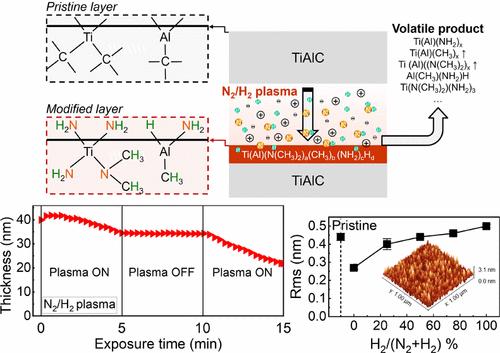室温下利用低压 N2/H2 等离子体对金属碳化物 TiAlC 进行无卤干法蚀刻
IF 8.3
2区 材料科学
Q1 MATERIALS SCIENCE, MULTIDISCIPLINARY
引用次数: 0
摘要
三元金属碳化物 TiAlC 已被提议用作逻辑半导体器件的金属栅极材料。由于蚀刻副产物挥发性低,它是一种难以蚀刻的材料。在此,我们首次提出了一种简单、高度可控的干法蚀刻 TiAlC 方法,该方法在低压(几帕)和 20 °C 下使用非卤素 N2/H2 等离子体。该方法使用电容耦合等离子体蚀刻器生成含有 N、NH 和 H 等活性物种的 N2/H2 等离子体,以改变金属碳化物表面。通过使用 N2/H2 等离子体,TiAlC 的蚀刻速率为 3 nm/min,而在相同条件下使用纯 N2 等离子体或纯 H2 等离子体则不会发生蚀刻。用 N2/H2 等离子体蚀刻的 TiAlC 薄膜的表面粗糙度可控制在原子水平。得到的蚀刻表面光滑,均方根粗糙度为 0.40 nm,与 0.44 nm 的初始粗糙度相当。通过使用高分辨率光学发射光谱仪检测 336 纳米波长的 NH 分子线,诊断了 N2/H2 等离子体的等离子特性。使用原位光谱椭偏仪、原位衰减全反射-傅立叶变换红外光谱仪和 X 射线光电子能谱仪研究了 N2/H2 等离子体与 TiAlC 之间的蚀刻行为和等离子体表面反应。研究结果表明,N2/H2 等离子体蚀刻的 TiAlC 表面形成了 N-H、C-N 和 Ti(Al)-N 键。提出了 TiAlC 的蚀刻机理,涉及无机材料(金属碳化物)和无机蚀刻剂(N2/H2 等离子体)之间的转化反应,形成挥发性有机化合物,如甲基化、甲基氨基化和氨基化金属。在蚀刻过程中使用了无卤素或无机化合物蚀刻剂。这项研究为大规模集成电路的微细加工提供了有益的启示。本文章由计算机程序翻译,如有差异,请以英文原文为准。

Nonhalogen Dry Etching of Metal Carbide TiAlC by Low-Pressure N2/H2 Plasma at Room Temperature
Ternary metal carbide TiAlC has been proposed as a metal gate material in logic semiconductor devices. It is a hard-to-etch material due to the low volatility of the etch byproducts. Here, a simple, highly controllable, and dry etching method for TiAlC has been first presented using nonhalogen N2/H2 plasmas at low pressure (several Pa) and 20 °C. A capacitively coupled plasma etcher was used to generate N2/H2 plasmas containing active species, such as N, NH, and H to modify the metal carbide surface. The etch rate of TiAlC was obtained at 3 nm/min by using the N2/H2 plasma, whereas no etching occurred with pure N2 plasma or pure H2 plasma under the same conditions. The surface roughness of the TiAlC film etched by N2/H2 plasma was controlled at the atomic level. A smooth etched surface was achieved with a root-mean-square roughness of 0.40 nm, comparable to the initial roughness of 0.44 nm. The plasma properties of the N2/H2 plasmas were diagnosed by using a high-resolution optical emission spectrometer, detecting the NH molecular line at 336 nm. The etching behavior and plasma–surface reaction between N2/H2 plasma and TiAlC were investigated by using in situ spectroscopic ellipsometry, in situ attenuated total reflectance-Fourier transform infrared spectrometry, and X-ray photoelectron spectroscopy. The findings indicate that the N–H, C–N, and Ti(Al)–N bonds form on the TiAlC surface etched by the N2/H2 plasmas. The mechanism for etching of TiAlC involving transformation reactions between inorganic materials (metal carbides) and inorganic etchants (N2/H2 plasma) to form volatile organic compounds such as methylated, methyl-aminated, and aminated metals is proposed. Nonhalogen or nonorganic compound etchants were used during the etching process. The study provides useful insights into microfabrication for large-scale integrated circuits.
求助全文
通过发布文献求助,成功后即可免费获取论文全文。
去求助
来源期刊

ACS Applied Materials & Interfaces
工程技术-材料科学:综合
CiteScore
16.00
自引率
6.30%
发文量
4978
审稿时长
1.8 months
期刊介绍:
ACS Applied Materials & Interfaces is a leading interdisciplinary journal that brings together chemists, engineers, physicists, and biologists to explore the development and utilization of newly-discovered materials and interfacial processes for specific applications. Our journal has experienced remarkable growth since its establishment in 2009, both in terms of the number of articles published and the impact of the research showcased. We are proud to foster a truly global community, with the majority of published articles originating from outside the United States, reflecting the rapid growth of applied research worldwide.
 求助内容:
求助内容: 应助结果提醒方式:
应助结果提醒方式:


